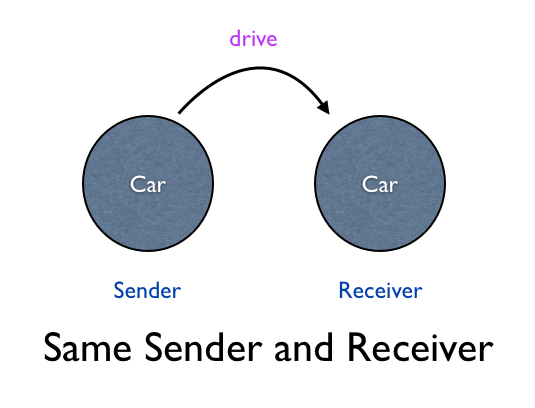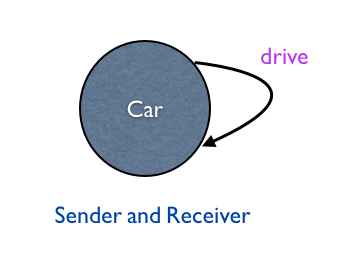The Default Receiver
In this chapter, you will learn that when you don't provide an explicit receiver in the code, Ruby uses self as the default receiver object.
The self Within Car
Let's define a Car class and print the value of self inside the Car class.
class Car
puts self
end
This prints:
Car

The drive Class Method
Let's define a drive() class method in the Car class.
class Car
def self.drive
p 'driving'
end
end
We know that the value of self is Car. This is the same as:
class Car
def Car.drive
p 'driving'
end
end
Call the Class Method
Explicit Receiver
We can call the drive() class method inside the Car class.
class Car
def self.drive
p 'driving'
end
Car.drive
end
This prints:
driving
We can also use self instead of Car to call the drive() class method.
class Car
def self.drive
p 'driving'
end
self.drive
end
This also prints:
driving
Call the Class Method
No Receiver
We know the value of self inside the Car class is Car. We can omit the self from the above example.
class Car
def self.drive
p 'driving'
end
drive
end
This prints:
driving
We don't have the dot notation that sends a message or the receiver object. The message is sent to the current value of self whenever you call a method with no receiver. Since the current value of self is Car, we are able to call the drive class method. In this example, Car is the default receiver object.
Fabio Asks
Why is it called default receiver?
Because, when you don't provide an explicit receiver, the current value of self defaults as the receiver.
Rhonda Asks
Why do we need a receiver to send a message?
In a OO language like Ruby, all messages are sent to some object.
Insight
There is another way to think about this example. You can say that whenever the sender object and the receiver object is the same, you can omit the receiver.


We will revisit this idea in an upcoming chapter.
Subclass Calling Class Method
The example may seem trivial, but this allows us to write code like this:
class Car
def self.drive
p 'driving'
end
end
class Beetle < Car
drive
end
This example prints:
driving
Rails Example
This is like ActiveRecord library in Rails. Imagine that ActiveRecord find() implementation is like this:
class ActiveRecord
def self.find(id)
p "Find record with id : #{id}"
end
end
In our web application we have a Beetle subclass of ActiveRecord as the model.
class Beetle < ActiveRecord
end

In the controller, we use the find method:
Beetle.find(1)
This prints:
"Find record with id : 1"
The dot notation makes sending messages explicit. If the receiver and the sender is the same, you can omit the receiver and the dot. In this case, Ruby will use value of self as the receiver. Thus, self is the default receiver.
Summary
In this chapter, you learned that the message is sent to the current value of self when you call a method with no receiver. This object is called the default receiver.